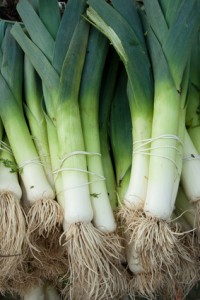Cooking With Leeks
A note on cooking with leeks, inspired by a NYT Well post with a list of related Recipes for Health:
I use leeks all the time, as my neighbors are probably too aware. I use leeks sautéed in olive oil as filler, mixed with an egg and flour for a tart, or to season simple pasta, or to flavor and decorate roasted potatoes.
First I cut off the base and ragged tips of 3-4 stems, slice the mainly dark-green stems lengthwise, and then cut the stalks into 1 – 3 inch sections, depending on what they’ll be used for. Because there’s often dirt from the ground deep in the lower, paler sections of the leeks, I manually expose and separate each rounded layer, and then wash everything under briskly-running water, thoroughly rinsing at least three times.
You don’t have to dry the cut, washed leeks. What I do is heat a heavy, wide pan on the stove, add a thin layer of olive oil, and then throw on the damp (or dry) leek pieces. With the flame set low, I toss on about a half teaspoon of salt for a volume of 3-4 large stalks. Sometimes I add fresh ginger, cut into tiny pieces, into the mix.
And then I work on other things in the kitchen – often while listening to NPR or talking to my mom on the phone – while the leeks wilt. If I’m running late, I’ll put a lid on the pan, which makes the leeks soften faster, but that’s not ideal. Every few minutes I stir them around a bit with a wooden spoon or spatula, until they’re soft and, typically, shiny with varied shades of green.
You can store cooked leeks in the refrigerator for a few days, if they’re in a sealed container. So you might, as I have, use a small amount with pasta on a Monday, and then use the remainder for a goat cheese and leek tart later in the week. There are many variations, and I’ve only started using this vegetable in the past four years or so.
This summer I intend to try making a potato-leek soup.
According to Martha Rose Shulman, writing for the Times, leeks are milder than onions but contain sulfur compounds present in onions and green garlic that some people find hard to digest. Leeks are a good source of nutrients like lutein and zeaxanthin, carotenoids – thought to be important in vision, calcium, iron, magnesium, phosphorus, potassium and vitamin K. Leeks are fiber-rich, I might add.
I should learn more about each of these elements; how they’re best cooked and absorbed. Unfortunately I’m still searching for the nutrition textbook they never assigned in med school.
—

Hi Elaine,
I just finished a nutrition class as a part of my Health Com graduate program at Boston University. We used an excellent textbook called Nutrition and You by Joan Salge Blake. It’s an extremely well organized text and was just updated in January 2011.
In the mean time, I love this delicious and easy recipe for potato leek soup from Cook’s Illustrated (and best of all it doesn’t contain cream):
http://www.cooksillustrated.com/recipes/detail.asp?docid=23258&frtk=8Oq118ldorj7k6BO62Huj1Ej643441iH
Jamie Rauscher
Hi Jamie, Thanks for both of these tips. I need a nutrition book, for a future book…And potato-leek soup without cream is just the kind I hope to make.
A few leek recipes using leeks from the archives –
http://www.tbtam.com/?s=leeks
Thanks for reminding me how much I love these veggies. Best I ever had were simply sauteed, in Paris (of course…)n